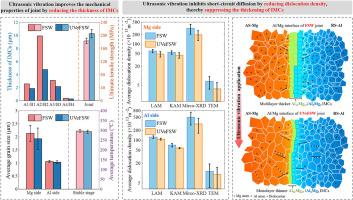Unveiling the mechanism of ultrasonic vibration on suppression of intermetallic compound growth in Al/Mg dissimilar friction stir welding
IF 13.8
1区 材料科学
Q1 METALLURGY & METALLURGICAL ENGINEERING
引用次数: 0
Abstract
The formation of hard and brittle intermetallic compounds (IMCs) is a critical challenge in the friction stir welding (FSW) of Al/Mg dissimilar alloys, severely deteriorating joint integrity and mechanical performance. Although novel ultrasonic vibration-enhanced friction stir welding (UVeFSW) has been shown to reduce IMCs thickness, the underlying suppression mechanism remains unrevealed. In this study, the role of ultrasonic vibration (UV) in mitigating IMCs formation during the FSW of Al/Mg dissimilar alloy was systematically studied using both experimental and numerical methods. TEM was employed to characterize the IMC layer thickness and grain morphology at the Al/Mg interface within the weld nugget zone. In-situ temperature measurements revealed negligible differences in average welding temperatures between conventional FSW and UVeFSW, with both remaining well below the eutectic temperature. This confirms that IMC formation primarily proceeds through solid-state atomic diffusion. EBSD, micro-XRD, and TEM analyzes consistently showed that UV significantly reduces GND density and overall dislocation content in the interfacial region. It was found that UV suppresses short-circuit diffusion by decreasing dislocation density at the bonding interface, thereby lowering the Al/Mg atomic diffusion rate and effectively reducing the overall IMCs thickness. These findings offering a transformative approach to enhancing the interfacial integrity and mechanical performance of Al/Mg dissimilar welded joints.

揭示了超声振动抑制Al/Mg异种搅拌摩擦焊中金属间化合物生长的机理
硬脆金属间化合物(IMCs)的形成是Al/Mg异种合金搅拌摩擦焊(FSW)的关键问题,会严重影响接头的完整性和力学性能。虽然新型超声振动增强搅拌摩擦焊(UVeFSW)已被证明可以降低IMCs的厚度,但潜在的抑制机制仍未揭示。本文采用实验和数值方法,系统研究了超声振动(UV)对Al/Mg异种合金FSW过程中IMCs形成的抑制作用。采用透射电镜对熔核区Al/Mg界面处的IMC层厚度和晶粒形貌进行了表征。现场温度测量显示,传统FSW和UVeFSW的平均焊接温度差异可以忽略不计,两者都远低于共晶温度。这证实了IMC的形成主要是通过固态原子扩散进行的。EBSD, micro-XRD和TEM分析一致表明,UV显著降低了界面区域的GND密度和总体位错含量。发现紫外通过降低键合界面处的位错密度来抑制短路扩散,从而降低Al/Mg原子扩散速率,有效地降低了整体IMCs厚度。这些发现为提高Al/Mg异种焊接接头的界面完整性和力学性能提供了一种革命性的方法。
本文章由计算机程序翻译,如有差异,请以英文原文为准。
求助全文
约1分钟内获得全文
求助全文
来源期刊

Journal of Magnesium and Alloys
Engineering-Mechanics of Materials
CiteScore
20.20
自引率
14.80%
发文量
52
审稿时长
59 days
期刊介绍:
The Journal of Magnesium and Alloys serves as a global platform for both theoretical and experimental studies in magnesium science and engineering. It welcomes submissions investigating various scientific and engineering factors impacting the metallurgy, processing, microstructure, properties, and applications of magnesium and alloys. The journal covers all aspects of magnesium and alloy research, including raw materials, alloy casting, extrusion and deformation, corrosion and surface treatment, joining and machining, simulation and modeling, microstructure evolution and mechanical properties, new alloy development, magnesium-based composites, bio-materials and energy materials, applications, and recycling.
 求助内容:
求助内容: 应助结果提醒方式:
应助结果提醒方式:


